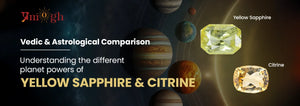Among gemstones, no hue draws such attention and positive energy as yellow. Two of the most sought-after yellow gemstones, Yellow Sapphire and Citrine, are usually mistaken for one another because of their colour similarity. While both gemstones emit a golden, warm light, in their physical characteristics, astrological qualities, and price, they have very different characteristics. For anyone thinking of wearing a yellow gemstone for jewellery, healing, or astrology, it is necessary to know the difference between the two.
To the naked eye, a fine Citrine or Sunela can easily be confused with a Yellow Sapphire or Pukhraj Stone. But that is where the resemblance ends. Pukhraj Stone is a precious corundum family gemstone, while Citrine is a semi-precious quartz family stone. They have completely different mineral compositions, and hence, there are differences in their hardness, brilliance, and durability. In ancient Vedic astrology, both these stones are associated with different planetary energies, and therefore, their applications and benefits are different. Let us understand why one is a powerful celestial talisman and the other is a beautiful and economical crystal.
Yellow Sapphire VS Citrine: Physical Comparison

The simplest and most neutral method for differentiating between Yellow Sapphire and Citrine is to compare their physical and chemical properties.
Hardness (Mohs Scale)
This is the most notable physical variation. The higher the hardness, the more hard and durable the stone is.
- Yellow Sapphire: Pukhraj stone is a very hard gemstone, with a hardness of 9 on the Mohs scale, just below diamond. This makes it a very good choice as a daily wear stone in rings and other jewellery, as it is highly resistant to scratching and wear.
- Citrine: Sunela is much softer, with a Mohs hardness of 7. Although it is still used in jewellery, it is more prone to scratching and chipping than a Pukhraj Stone.
Refractive Index and Lustre
The refractive index of a gemstone determines how much it bends and reflects light, and the brilliance and sparkle it subsequently displays.
- Yellow Sapphire: Pukhraj stone has a high refractive index of 1.76-1.77, which gives it a hot, fierce brilliance that is more akin to describing it as having a "diamond-like" sparkle.
- Citrine: Citrine's refractive index is lower, at 1.54-1.55, and its sparkle is then less brilliant, more glassy. Placed under light, a Pukhraj will display a much sharper and intense sparkle than Sunela.
Inclusions and Imperfections
Every gemstone has some type of inclusions. The presence of inclusions determines whether the stone is natural or man-made.
- Yellow Sapphire: It will generally contain small, silk-like imperfections, fine lines, or other mineral inclusions that appear when viewed under magnification. These are natural inclusions and are an indication of a natural Pukhraj stone.
- Citrine: This gemstone belongs to the quartz family, is usually very clean and may contain fewer inclusions. Some Sunela stones, however, can contain fine, parallel lines or fissures.
Price and Value
This is where the contrast is most apparent. The price of the gemstone is set by the "4 Cs", that is, colour, clarity, cut, and weight.
- Yellow Sapphire: Because of the rarity, hardness, and brilliance of Pukhraj, it is an investment gemstone of high market value. The price of Pukhraj stone starts from ₹1,000 per carat
- Citrine: Sunela, as a more common mineral, is a semi-precious gem, and it is less expensive. Although a large, high-quality Citrine can be lovely, it possesses no investment value like a natural Pukhraj. The price of Citrine starts from ₹500 per carat
Vedic and Astrological Comparison: The Power of Planetary Energy

In Vedic astrology, the difference between the two stones is of utmost importance. The two stones are yellow in colour, but the energies and planets associated with each stone are different.
Yellow Sapphire (Pukhraj Stone)
This gemstone is associated with the planet Jupiter, or 'Guru' or Brihaspati, in Vedic astrology. Jupiter is a planet of knowledge, wealth, fortune, and spirituality. Pukhraj Stone is believed to correct a weak or debilitated Jupiter in the birth chart, thus drawing its auspicious energies. The benefits of pukhraj stone are:
- Enhances Prosperity and Wealth: It is said to provide new chances for life, increase economic progress, and create stability.
- Increases Marital Harmony: Pukhraj is most suitable for those who want a good partner and a successful, blissful married life.
- Brings Wisdom and Intellect: It improves one's decision-making skills, sharpens the mind, and enhances knowledge.
- Improves Health: Astrologically, it is believed to help the wearer with liver, kidney, and digestive issues.
Citrine (Sunela)
It is a strong crystal that is also known as the "stone of abundance" and is often recommended as the best alternative to Yellow Sapphire. Not a main planetary stone in classical Vedic astrology, but greatly appreciated in contemporary crystal healing. The energy of this stone is believed to be life-affirming, radiant, and purifying. The benefits of citrine are:
- Attracts Wealth: It is referred to as the "merchant's stone" and is said to attract wealth and business success.
- Maintains Emotional Balance: It is known to foster joy, hope, and emotional clarity, eliminating negative energy.
- Brings Creativity and Confidence: It is used as a stone to enhance self-confidence and stimulate creativity.
- Helps in Manifestation: People believe that this gemstone helps them manifest their desires and dreams.
Which Stone is Better for You?
Between Sunela and Pukhraj stone, you can pick either one completely based on your intention.
Choose Yellow Sapphire If:
Your main intention is to channel the astrological energy of Jupiter. If you want to advance your career, gain money, or have a good life partner, a natural, fine-quality Pukhraj stone is the best option. Seek advice from an expert astrologer to know whether Jupiter is a supportive planet for you and to buy the right Pukhraj gemstone.
Choose Citrine If:
You'd prefer a lovely, affordable gemstone to add to a piece of jewellery or if you are experimenting with crystal healing. Citrine is a soothing, uplifting energy and a great stone to use to bring in prosperity and good energy. It's a beneficial stone to use for personal meditation and to bring a sense of joy and optimism into your world.
Final Thoughts
While Pukhraj Stone and Sunela may look the same as they share the same golden colour, they are worlds apart in every other aspect. Yellow Sapphire is a precious, hard, and astrologically strong gemstone of the corundum family, which bears a direct relation with the planet Jupiter. Citrine is a beautiful, affordable, and high-vibrational quartz crystal, which is renowned for its ability to attract happiness and abundance. Both gemstones are gorgeous in their own right, yet they are utilised for different purposes. Having knowledge of their individual properties, you can choose the stone that resonates with you perfectly, whether it has its roots in ancient astrological tradition or modern crystal healing modalities.
FAQs
Can Citrine be used as a substitute for Pukhraj in Vedic astrology?
Yes, Citrine can be used as a substitute for Pukhraj. Though Citrine is not an astrological replacement for Pukhraj in classical Vedic astrology, Pukhraj is the main gemstone for the planet Jupiter and carries its vibrations, particularly in tune with this planet. Citrine is a semi-precious quartz gemstone and is not a Navratna or a planetary gemstone. Wearing a natural yellow Pukhraj is very important from an astrological point of view to harness the real energy of Jupiter.
Which among them is more expensive, Yellow Sapphire or Citrine?
Yellow Sapphire is far more costly than Sunela. Pukhraj is a precious gemstone, whereas Citrine is a semi-precious gemstone. Pukhraj’s scarcity, superb hardness, and superior brilliance are the reasons why it commands such a high market price. Sunela is far more common and hence cheaper, and it is highly suitable for inexpensive jewellery.
How do I distinguish a natural Yellow Sapphire from a Citrine by appearance?
A natural Pukhraj will usually have much more fiery, intense brilliance because of its high refractive index. It will usually exhibit typical, natural inclusions such as fine "silk" threads that can be seen under magnification. Citrine, on the other hand, has a more glassy, dull appearance and will usually be cleaner with fewer inclusions visible. A scratch test, although not advisable at home, would also reveal that a natural Sapphire gemstone is much harder than a Citrine.
Do both stones have the same advantages for wealth and prosperity?
Although both stones are linked to prosperity, they function differently. Pukhraj, linked to Jupiter, is said to acquire fortune, career advancement, and financial stability by aligning with cosmic energies. Citrine, the "merchant's stone", is linked to manifesting overall prosperity and good fortune in business and life through its sunny and positive energies.
Is one stone more resistant than the other for everyday wear?
Yes, Yellow Sapphire is much stronger than Citrine. Pukhraj stone, rated 9 on the Mohs scale, is highly resistant to chipping and scratching and is an excellent choice for a gemstone to be worn daily, such as a ring. Citrine, rated 7, is tough but will get damaged more easily and should be worn with a bit more care.
Do Yellow Sapphire and Citrine share the same colours?
While both are yellow, their colour range and hue may differ. Pukhraj may range from pale lemon yellow to deep golden yellow. Citrine's natural colour, as found in the market, is usually reddish-yellow or burnt orange. A natural Citrine's natural colour is usually light yellow.








































